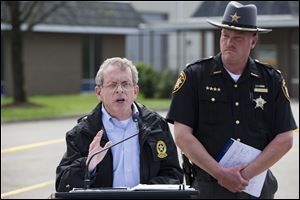
PIKE COUNTY
Reward lacking in 8 slayings in S. Ohio
Tie to drugs may be reason
4/21/2017COLUMBUS — A year after the mysterious killings of eight family members in south central Ohio, investigators are concerned that more reward money hasn’t been offered and fear that some victims’ involvement in drugs may be the reason.

In this April 27, 2016, file photo, Ohio Attorney General Mike DeWine, left, and Pike County Sheriff Charles Reader, right, discuss the slayings of seven adults and a 16-year-old boy from the Rhoden family found shot April 22, 2016.
The amount for information leading to a conviction remains at $10,000, much less than similar recent offers.
In Cleveland, for instance, the reward for information about a man who recorded himself fatally shooting someone and posted it on Facebook hit $50,000 almost immediately.
Suspect Steve Stephens shot and killed himself Tuesday in Erie, Pa., as police closed in. In Indiana, the award in the unsolved February slayings of two teenage girls is now more than $230,000.
Pike County Sheriff Charles Reader has raised concerns that alleged large-scale drug activity by one victim is suppressing donations.
Sheriff Reader pleaded for more donations last week as the anniversary approaches on Saturday. No arrests have been made and officials have not said whether they have any suspects.
“If you can help with the reward, and get the reward money up, that can sometimes make a big difference,” Sheriff Reader said.
On April 22, 2016, investigators found seven adults and a teenage boy from the Rhoden family shot to death at four homes near Piketon, about 70 miles south of Columbus. Three young children were unharmed.
One of the victims, Christopher Rhoden, Sr., operated a commercial marijuana growing operation on his property “with the purpose of distributing the marijuana,” according to the office of Attorney General Mike DeWine, whose office is leading the investigation.
Soon after the shootings, Cincinnati-area restaurateur Jeff Ruby donated a $25,000 reward.
But days later, he said he was withdrawing the reward because of “recent complex criminal developments” in the case.
The sheriff said people shouldn’t let the drug allegations hold back their willingness to make donations.
“These are human beings, regardless of what they did for a living, regardless if they live in rural Pike County,” the sheriff said.
Southern Ohio Crime Stoppers offered the reward in July without saying where the money came from.
Rewards do provide incentives for people to come forward and the amount of a reward can bring extra attention to a case, said Greg Champagne, sheriff of St. Charles Parish in Louisiana and president of the National Sheriffs Association.
At the same time, a reward is only as good as the information that’s available, he said.
“Whether it’s $10,000 or $200,000, if you don’t have the information, you can’t manufacture evidence,” Sheriff Champagne said.
An appearance that victims are tainted somehow can influence how much people want to donate, said Mike Allen, a Cincinnati defense attorney and former Hamilton County Prosecutor.
“If you have unsympathetic victims, people aren’t going to want to pony up and put any money towards it,” Mr. Allen said.